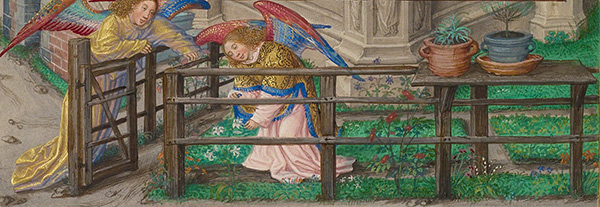
The Annunciation (detail), about 1510–20, Master of James IV of Scotland. Tempera colors, gold, and ink on parchment, 9 1/8 x 6 9/16 in. Ms. Ludwig IX 18, fol. 92v
Throughout 2013, the Getty community participated in a rotation-curation experiment using the Getty Iris, Twitter, and Facebook. Each week a new staff member took the helm of our social media to chat with you directly and share a passion for a specific topic—from museum education to Renaissance art to web development. Getty Voices concluded in February 2014.
“If you have a garden and a library, you have everything you need.” —Cicero
In this post, Bryan Keene of the Museum’s Department of Manuscripts takes us on a journey through the gardens of the Renaissance as seen on the pages of sumptuous illuminated manuscripts.—Ed.
For the past three years, I’ve been thinking about Renaissance gardens, and here at the Getty I benefit daily from the truth inherent in Cicero’s timeless words. Whatever my day-to-day responsibilities in the Department of Manuscripts, I’m fortunate to have at hand the breathtaking gardens of the Getty Center and Villa, as well as the resources of the Getty Research Institute, one of the world’s most comprehensive art historical libraries. I also have access to a library of another kind in the form of the manuscripts collection, from which I envisioned the exhibition Gardens of the Renaissance (to go on view May 28–August 11, 2013).
The actual gardens at the two Getty campuses are constant sites of learning, relaxation, and sensorial exhilaration for visitors and staff alike, and I hope that this week’s journey through gardens—from the pages of manuscripts to the green spaces at the Getty—will equally delight and inspire.
A “Renaissance garden” is not a singular concept, and it can’t be delineated neatly along geographic or chronological lines. But we can make some broad generalizations about gardens, botany, and the natural world during the Renaissance in Europe. Villa gardens in central Italy, for example, were often designed around an ideal, proportional system of geometry, according to which the garden linked the house and the surrounding countryside along an axis. This planting system was later applied to gardens beyond Italy, and although many of these gardens have changed since the time of their cultivation, an illumination from a 17th-century German manuscript (below) presents a house and garden planted with a grid-axis that belonged to one Magdalene Pairin in 1502, over a century earlier. This garden appears much the same today as it did when this manuscript was created.

The Nuremberg Residence and Garden of Magdalene Pairin in Genealogy of the Derrer Family, about 1626–1711, Georg Strauch. Tempera colors and gold leaf and ink on parchment, 14 13/16 x 10 ¼ in. (37.6 x 26 cm). The J. Paul Getty Museum, Ms. Ludwig XIII 12, fol. 130 bis
The Renaissance saw an increased concern for naturalism, which can be seen in the spellbinding botanical precision of Joris Hoefnagel’s Pomegranate, Worm, and Peach, below. This illumination—and about 100 other pages featuring plants, flowers, and fruits—adorn the pages of the Model Book of Calligraphy, which was made in two phases for the Holy Roman Emperors Ferdinand I (the inked writing samples by Georg Bocskay, 1561–62) and Rudolph II (the painted illuminations by Joris Hoefnagel, 1591–96). Emperor Rudolph owned several pleasure gardens and botanical gardens, and it’s tempting to imagine the Model Book of Calligraphy as a visual record of the marvelous plants grown in his realm.

Pomegranate, Worm, and Peach in Model Book of Calligraphy, illumination 1591–96, script 1561–62, Joris Hoefnagel, illuminator; Georg Bocskay, scribe. Watercolors, gold and silver paint, and ink on parchment, 6 9/16 x 4 7/8 in. (16.6 x 12.4 cm). The J. Paul Getty Museum, Ms. 20, fol. 83
When I examine the visual record of gardens in works of art from the Renaissance, I’m constantly intrigued by the various paradoxes inherent in how individuals pictured, used, or enjoyed these idyllic green spaces. Over the next five days on Getty Voices, I’ll explore with you several of these paradoxes: the Natural and the Artificial; Sin and Salvation; Virtue and Vice; Symbols and Science; Cloister and Court.
Our focus will be the visual riches of illuminated manuscripts from the Getty Museum’s collection made between 1400 and 1600. Join me in a journey of learning, relaxation, and sensory exhilaration as we virtually visit gardens of the Renaissance.
About the Cicero quote—I first saw this phrase on a magnet given to me by my friend and colleague Kristen Collins. The words are taken from Cicero’s letter to M. Terentius Varro, found in book 9, letter 3 of his Letters to Friends (62–47 B.C.).
Connect with more “Renaissance Garden” content from this week’s Getty Voices:
- Bryan Keene talks romance, tranquility, mischievousness, and sensuality in the Renaissance Garden.




A sensual experience to reflect on our nature. Human conscious glorifies nature.
Hi Bryan,
When looking at these Renaissance gardens, I can’t help but be reminded of Roman Villa gardens and the garden fresco wall paintings found in Roman houses – is there any connection between the two?
Thanks for this beautifully illustrated post,
Jill
Solomons Gardens jerusalem.
I’ve enjoyed this post and Bryan’s tweets so much. I’m feeling a bit bereft at having this particular conversation end.
Hi Cynthia—How wonderful, thank you! It is sad to leave gardens behind, but never fear, the exhibition “Gardens of the Renaissance” curated by Bryan is coming May 28 to the Getty Center. And his book, too. —Annelisa/Iris editor